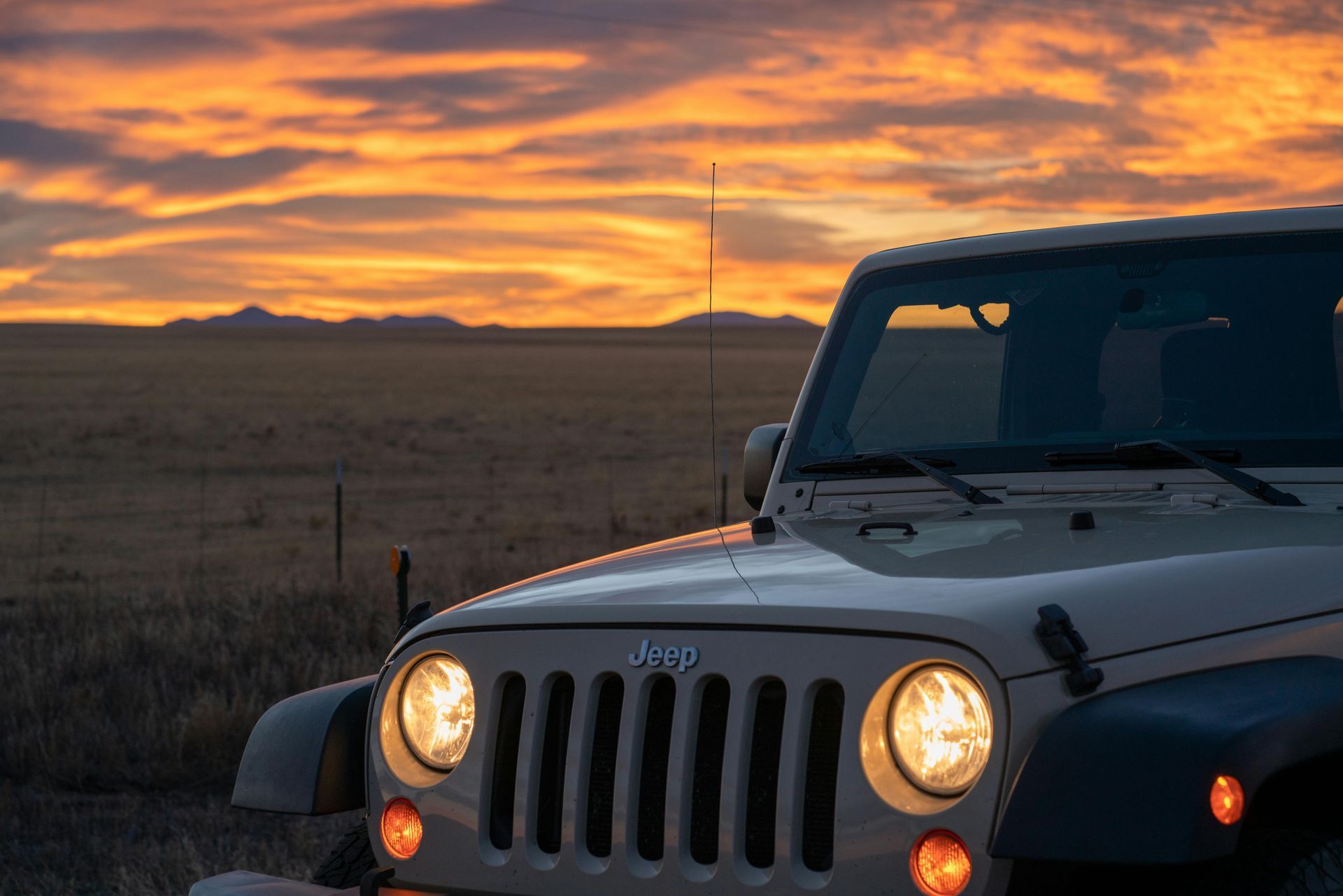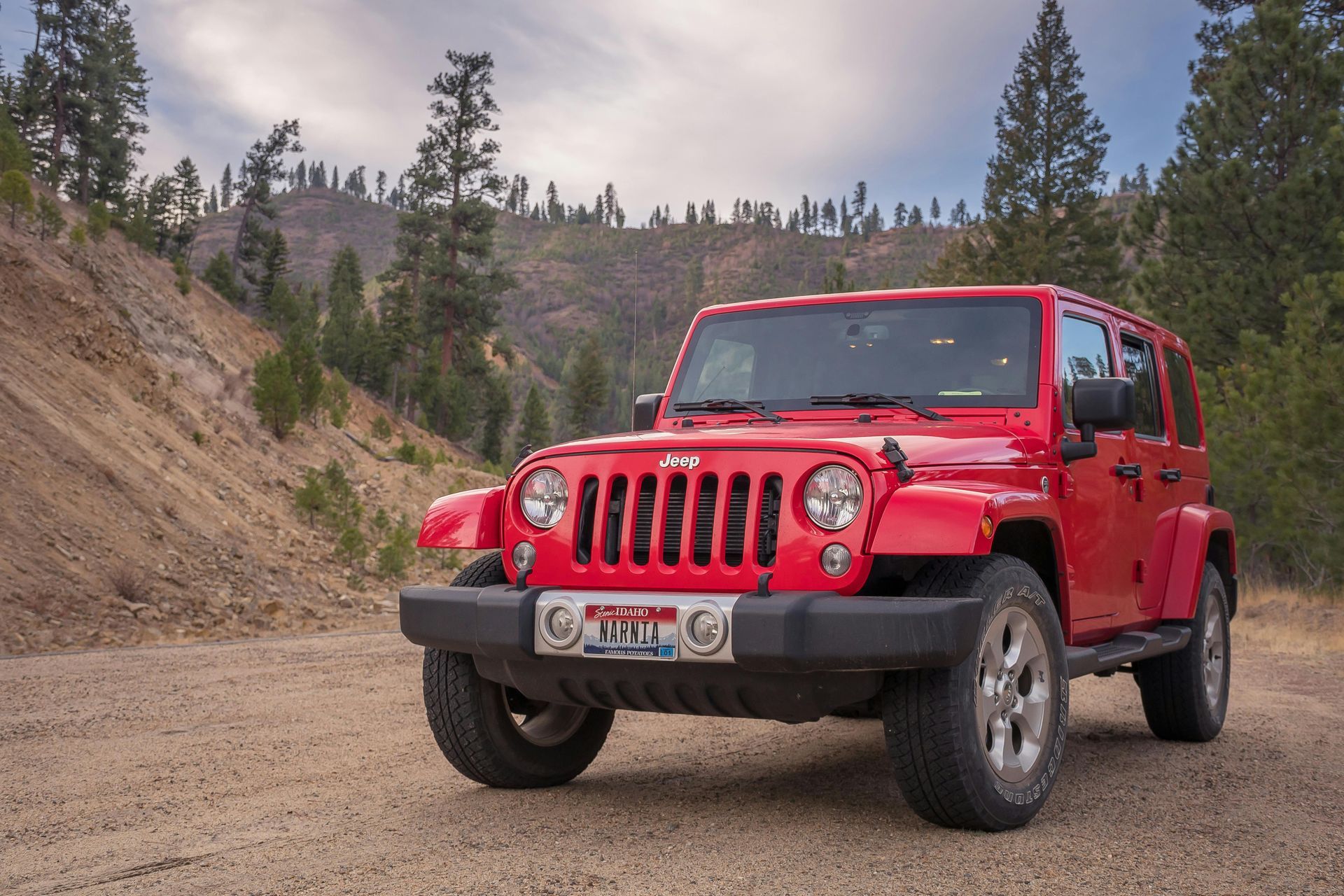History of an American Icon : The Jeep Wrangler
Justin Sonon • August 14, 2025
Learn how this wartime vehicle became an American Icon

The History of the Jeep Wrangler: From Battlefield Hero to Off-Road Legend
Few vehicles have a history as rich and recognizable as the Jeep Wrangler. Known for its rugged build, unmistakable design, and unmatched off-road capability, the Wrangler’s story began long before it rolled onto modern highways — it was forged in the fires of World War II and evolved into a cultural icon.
The Wartime Origins: 1940s
The Jeep’s story starts in 1940, when the U.S. military needed a light, durable, all-terrain reconnaissance vehicle for World War II. The Army issued specifications for a “General Purpose” vehicle, and manufacturers rushed to submit prototypes. Willys-Overland, alongside Bantam and Ford, developed the winning design, the Willys MB.
With its flat grille, round headlights, and simple, rugged frame, the Willys MB quickly became a wartime workhorse. It could go almost anywhere, survive tough conditions, and was easy to repair in the field. Soldiers loved it, and the Jeep became a symbol of freedom and durability.
Post-War Civilian Life: CJ Series (1945–1986)
After the war, Willys saw an opportunity to bring the Jeep to civilians. In 1945, they introduced the CJ-2A (“Civilian Jeep”), the first of the CJ series. These models kept the same go-anywhere spirit but were adapted for farming, hunting, and normal everyday use.
Over the decades, the CJ series evolved:
CJ-5 (1954): Longer wheelbase, updated styling, and improved comfort — making it the longest-running Jeep model at 30 years in production.
CJ-7 (1976): More room, optional automatic transmission, and better on-road manners without sacrificing trail performance.
By the mid-1980s, Jeep (then owned by AMC) decided it was time for a new generation.
The Birth of the Wrangler: YJ (1986–1995)
In 1986, the CJ line was retired, and the Jeep Wrangler YJ debuted. While purists noted changes — like square headlights — Jeep emphasized improved comfort, handling, and safety for daily driving. Still, the Wrangler maintained removable doors, a fold-down windshield, and serious off-road chops.
Refinement and Popularity: TJ (1997–2006)
The second-generation Wrangler, the TJ, reintroduced the beloved round headlights and added the coil spring suspension for a smoother ride. Jeep also introduced the Wrangler Unlimited (LJ), a longer-wheelbase version that improved cargo space and towing capability.
Modernization: JK (2007–2018)
The JK generation brought significant changes — a wider stance, updated interior, and the introduction of the four-door Wrangler Unlimited, which expanded Jeep’s appeal to families and adventure travelers. Advanced off-road systems, stronger axles, and electronic locking differentials made it even more capable.
Today’s Wrangler: JL (2018–Present)
The current JL Wrangler blends heritage with modern tech. It offers advanced safety features, updated infotainment systems, lighter materials, and multiple engine choices, including a plug-in hybrid option (Wrangler 4xe). The JL still carries the core DNA: open-air freedom, rugged design, and unmatched off-road performance.
A Lasting Legacy
From battlefields to mountain trails, the Jeep Wrangler has remained true to its roots for over 80 years. Its enduring design, versatility, and loyal fan base ensure that it will continue to be both a symbol of adventure and a piece of American automotive history.
Recent posts

Will Your Auto or Home Insurance Cover Your Mobile Device or Computer? Our phones and laptops aren’t just gadgets anymore, they’re lifelines. From handling business on the go to streaming that must-watch series at night, they’re practically extensions of ourselves. But what happens when the unexpected occurs? A drop, a theft, a spilled cup of coffee, will your auto or home insurance policy swoop in to save the day? Let’s break it down. Home Insurance & Your Tech Good news! Most homeowners and renters insurance policies can cover personal electronics like smartphones, tablets, and computers, at least up to policy limits. Theft or Fire : If your laptop is stolen from your home or damaged in a covered event like a house fire, your policy may reimburse you. Vandalism & Certain Storms : Same deal here. If your tech is damaged by something your policy specifically lists as covered, you’re in luck. But here’s the potential issue: coverage is usually subject to your deductible. If you have a $1,000 deductible and your device is worth $800, you might be out of pocket. 💡 Pro Tip: Ask your agent about scheduled personal property coverage or a rider, these can give your devices extra protection (and sometimes lower deductibles). Auto Insurance & Your Devices This one surprises people. If your phone or laptop is stolen from your car, your auto policy generally doesn’t cover it. Instead, it would fall back to your homeowners or renters insurance. However, your auto insurance can play a role if your car itself is damaged and your devices are harmed in the process. Example: a covered accident shatters your windshield and your laptop sitting in the passenger seat gets smashed. Some policies may extend limited coverage for items damaged inside the vehicle. Still, it’s not the main player here, think of your car insurance as handling the car first and foremost. What’s Not Typically Covered Accidental Damage (a.k.a. Clumsy Drops) : Most standard home or renters insurance won’t pay out if you drop your phone in the pool. Wear & Tear : If your laptop battery dies from age, that’s on you. Manufacturer Defects : That’s what warranties or protection plans are for. How to Make Sure You’re Protected Inventory Your Devices : Keep a running list (and receipts if you have them). Check Your Policy Limits : Electronics often have sub-limits that cap coverage. Consider Add-Ons : Riders or endorsements can provide stronger coverage for today’s high-ticket devices. Device Protection Beyond Your Plan While you’re safeguarding your tech, why not protect how you carry it? If you’re in the market for premium, durable, stylish leather accessories, check out our office favorites and get our exclusive 10% discount - Andar – Handcrafted Wallets & Tech Accessories These items don’t replace insurance, but they make sure your phone or computer travels in style and gets treated like the valuable gear it is. The Sonon Insurance Takeaway Insurance is about more than protecting the big stuff like your car or home, it’s also about safeguarding the tools that keep your everyday life running smoothly. If you rely on your devices (and who doesn’t?), make sure your coverage fits your lifestyle. At Sonon Insurance, we’ll walk you through what’s covered, what’s not, and how to fill in the gaps so your laptop or phone doesn’t leave you stranded in the digital stone age. ✅ Affiliate Disclosure & Legal Stuff We want to be transparent: some of the product links in this post are affiliate links—meaning Sonon Insurance may earn a commission if you click through and make a purchase. This comes at no extra cost to you, and we only promote products we genuinely believe will provide value. We’re not responsible for warranties, returns, or damage once the product is in your hands—any such policies come from the product brand itself.

Gap Insurance: Dealer Add-On vs. Auto Insurance Policy — Which Is the Smarter Choice? Buying a new car is exciting, but it also comes with financial risks. The moment you drive off the lot, your vehicle starts to depreciate in value. If your car is ever totaled or stolen, your standard auto insurance typically pays out the actual cash value, not the balance left on your loan or lease. That’s where Gap Insurance comes in. Short for Guaranteed Asset Protection, it covers the “gap” between what your vehicle is worth and what you still owe your lender. Why You’ll Hear About Gap Insurance at the Dealership When you’re finalizing your purchase, the finance manager often offers Gap Insurance as an add-on. Convenience : You can roll it right into your financing paperwork. Cost : This convenience comes at a price. Dealers typically charge $400– $900 as a one-time fee, and because it’s financed, you’ll also pay interest on it. Commitment : Once it’s bundled into your loan, you’re locked into that cost even if your balance drops faster than expected. For example: if you buy a $30,000 SUV and total it a year later when it’s worth only $24,000, but you still owe $28,000, the dealer’s Gap Insurance would cover the $4,000 difference. Useful—but not always cost-effective. Gap Insurance Through Your Auto Insurance Policy What many car buyers don’t realize is that they can add Gap Insurance directly to their auto insurance policy. Lower Cost : Most carriers charge just $20–$40 per year for the same protection. Flexibility : You can add or remove the coverage as your loan balance changes. Same Protection : It covers the same difference between your loan and your vehicle’s actual cash value. In the SUV example above, adding Gap Insurance through your policy would provide the same $4,000 protection—but at a fraction of the cost. Which Option Is Best? If you like convenience and don’t mind paying more, the dealership option works. If you want long-term savings, adding Gap Insurance to your auto policy is almost always the smarter financial choice. At Sonon Insurance , you can explore whether adding Gap Insurance to your auto policy makes more sense for your wallet. Because protecting your vehicle, and your finances, shouldn’t cost more than it has to.

